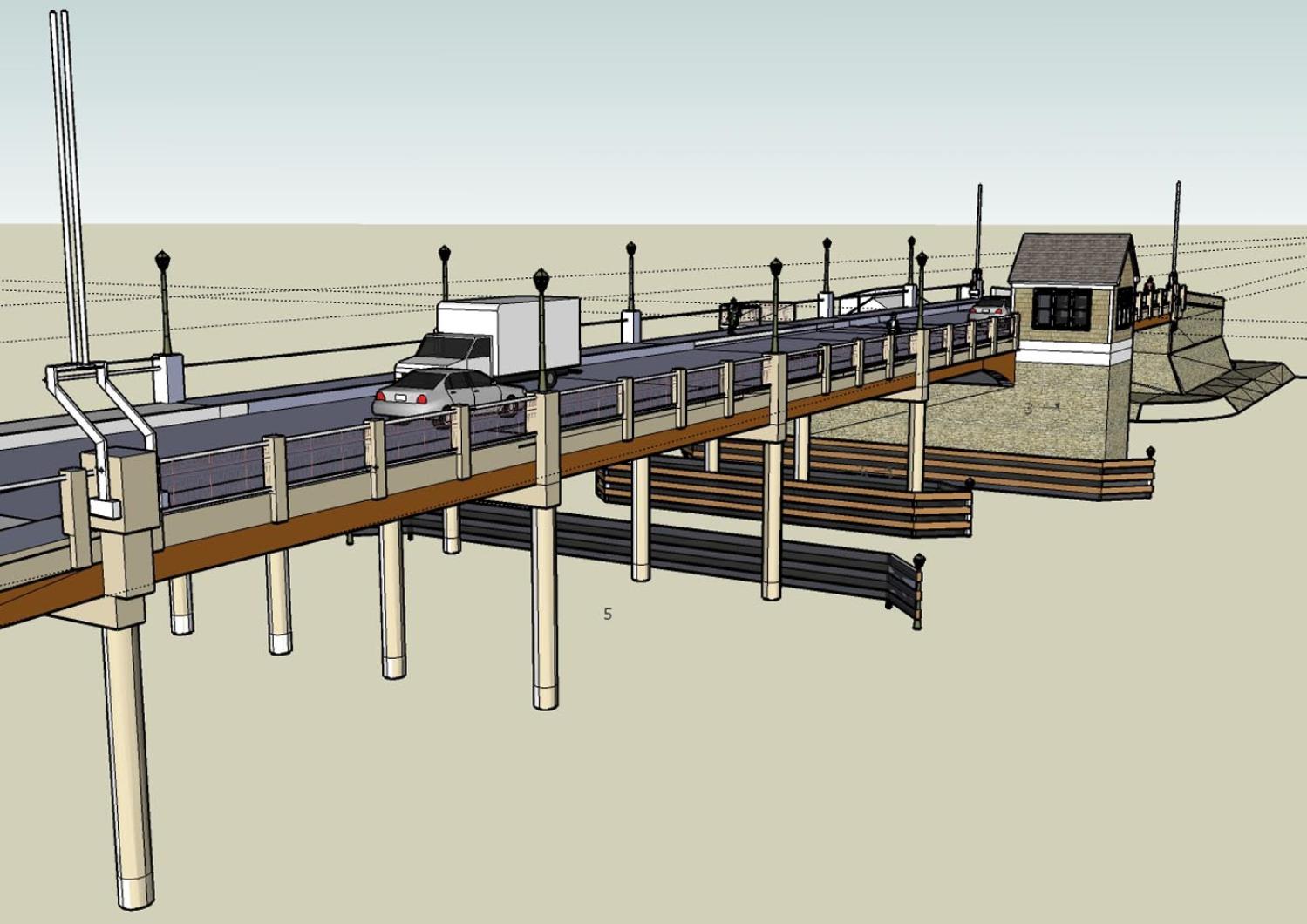For the first time, state officials on Wednesday publicly unveiled plans for a permanent retractable bridge and its estimated price tag of $35 million, slated to replace the failing Lagoon Pond drawbridge in Vineyard Haven.
Wednesday’s presentation by project planners and officials from MassHighway offered the first look at plans and renderings for the new permanent bridge. The presentation included a PowerPoint display and a three-dimensional computer simulation program that showed the new bridge from all angles.
After a long and sometimes choppy planning process, the bridge plans on Wednesday garnered a largely positive reaction.
Many who attended said they liked the overall design of the new bridge, especially features like a stairway on the Vineyard Haven side leading down to the water and special gates that swivel on a 180-degree axis and are hidden from view along the side of the bridge when not in use.
Steve McLaughlin, project manager for MassHighway, said planners have settled on the general concept for the permanent bridge. The main channel going into the pond will be shifted approximately 50 feet to the north, away from a peninsula of beach that juts out from Eastville beach, making it easier for boats to enter and exit the pond.
Plans call for a single-span bridge to be attached to the Vineyard Haven side, with the new operator’s booth located on the side facing the open ocean. All the pilings will be made of either concrete of steel, and the extensive wooden bracing beneath the bridge will be removed.
The new bridge will have two channels for boats to travel through: one covered by the drawbridge and another to the south with a fixed ceiling. The second channel will be approximately five feet higher than the current bridge and will allow more boats to travel to the pond without having to open the drawbridge.
Mr. McLaughlin began the meeting with good news — that the height of the bascule tower on the temporary bridge has been lowered substantially. The maximum height of the temporary bridge, which has drawn criticism, was previously slated to be between 60 to 70 feet. Mr. McLaughlin said the height has been lowered to approximately 30 feet.
Leslie Haines, project planner for Parsons Transportation Group, said the coming months will be a time for gathering public comment. She said the channel leading into the pond will be completely shut down to boat traffic at some point while the permanent bridge is installed — a process which could take between 12 and 14 months.
She said the new bridge will have two lanes for vehicular traffic, each 11 feet wide, as well as two 10-foot multi-use walkways and two six-foot sidewalks for pedestrians only.
Few specifics were offered about the dimensions of the bridge, including overall length, width and height.
William H. Lockwood of Lockwood Architects described two sets of specially designed gates: one to warn traffic the bridge is being raised and another, stronger gate capable of stopping oncoming cars. Both gates will rest on the side of the bridge when not in use and will come up and over the edge during operation.
Plans call for the construction of at least eight light poles along the roadway, although the lights may not wind up being part of the final design. Mr. Lockwood also showed four different versions of the operator’s house, each with a different roof.
Public comment consisted of mostly questions and suggestions.
Longtime bridge tender Robert Maciel urged planners to include a backup power source for the bridge in case of an emergency.
“They’ve been telling me for years they are getting a generator. It still hasn’t happened. One time the power went out and we hand-cranked [the bridge] for six hours and the thing barely moved. Power is very important to that bridge,” he said.
Tisbury selectman Tristan Israel spoke up for visual appeal.
“We all want to make sure the bridge is utilitarian and the boats are going to fit under it, but aesthetics are very important to the people who live here . . . we need this to be as sensible as possible,” he said.
Tisbury planning board member Henry Stephenson suggested the roof of the operator’s booth be reduced in size. Melinda Loberg, chairman of the drawbridge committee, said the new bridge should look like the existing bridge as much as possible, but “without all that junk underneath.” Tisbury selectman Denys Wortman spoke to the overall height of the bridge.
“Keep the profile down as low as possible. The less we notice the better,” he said.
Mark London, executive director of the Martha’s Vineyard Commission, suggested that a viewing area or fishing platform be included. “It’s a relatively low-cost item to add. If it makes the bridge more useful or more beloved, then why not?” Mr. London said.
Perhaps the biggest revelation was the overall cost of the project. Mr. McLaughlin said the latest estimate for the permanent bridge is around $35.7 million, while the cost of the temporary bridge is around $9.3 million, putting the overall price tag at around $45 million. The temporary bridge is currently under construction and due to be completed in May 2010.
The project is being funded through a combination of state and federal money.
Ralph Packer, owner of the R.M. Packer Co. in Vineyard Haven, praised the presentation. “You guys have made great progress, and I want to thank you. It seems like a good plan and a good deal, and I think the public will be pleased,” he said.
More public meetings will be held before a final design is chosen. Mr. McLaughlin said another meeting will be held in approximately six months.




Comments
Comment policy »